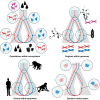Gearing up to handle the mosaic nature of life in the quest for orthologs
- PMID: 28968857
- PMCID: PMC5860199
- DOI: 10.1093/bioinformatics/btx542
Gearing up to handle the mosaic nature of life in the quest for orthologs
Abstract
The Quest for Orthologs (QfO) is an open collaboration framework for experts in comparative phylogenomics and related research areas who have an interest in highly accurate orthology predictions and their applications. We here report highlights and discussion points from the QfO meeting 2015 held in Barcelona. Achievements in recent years have established a basis to support developments for improved orthology prediction and to explore new approaches. Central to the QfO effort is proper benchmarking of methods and services, as well as design of standardized datasets and standardized formats to allow sharing and comparison of results. Simultaneously, analysis pipelines have been improved, evaluated and adapted to handle large datasets. All this would not have occurred without the long-term collaboration of Consortium members. Meeting regularly to review and coordinate complementary activities from a broad spectrum of innovative researchers clearly benefits the community. Highlights of the meeting include addressing sources of and legitimacy of disagreements between orthology calls, the context dependency of orthology definitions, special challenges encountered when analyzing very anciently rooted orthologies, orthology in the light of whole-genome duplications, and the concept of orthologous versus paralogous relationships at different levels, including domain-level orthology. Furthermore, particular needs for different applications (e.g. plant genomics, ancient gene families and others) and the infrastructure for making orthology inferences available (e.g. interfaces with model organism databases) were discussed, with several ongoing efforts that are expected to be reported on during the upcoming 2017 QfO meeting.
© The Author 2017. Published by Oxford University Press.
Figures

References
Grants and funding
LinkOut - more resources
Full Text Sources
Other Literature Sources

